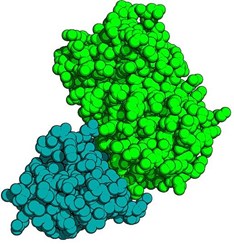New limit in protein complex stability: GFP-binding protein:GFP complex
ChromoTek's GFP Nanobody tightly binds GFP-fusion proteins even in 8 M urea at 51 °C
Although traditional IgG antibodies are often used for immunoprecipitation and protein interaction analysis, GFP-binding protein (GFP VHH, ChromoTek gt-250) and other ChromoTek VHHs easily outcompete those under challenging conditions such as elevated temperatures, varying pH or high denaturant concentrations. In fact, GFP VHH tightly binds GFP-fusion proteins even in 8 M urea at 51 °C, which sets a new limit in protein complex stability, virtually unrivalled by any other capture molecule protein tag pair.

Now what research would you do with your GFP-fusion proteins so tightly bound that you can hardly break? Imagine what’s possible when the GFP-fusions are bound to an affinity binder even in 8M urea, 3M guanidinium·HCl, or at 83°C?
Here are some suggestions, there will be more:
- Protein interaction analysis
The study of protein interactions by methods such as surface plasmon resonance (SPR, e.g. Biacore, GE Healthcare), biolayer interferometry (BLI, fortéBio), SwitchSense (Dynamic Biosensors), or surface acoustic wave (SAW, e.g. Nanotemper) requires the immobilization of a protein of interest on a biosensor. Ideally, this immobilization is unaffected by a large number of regeneration cycles under varying, often harsh chemical conditions. Here, we show that the ChromoTek GFP VHH (ChromoTek gt-250, biotinylated GFP VHH gtb-250) in combination with the widely used GFP-tag specifically answers to the need of high chemical stability and is thus an ideal candidate for a biosensor capture molecule.
- Immunoprecipitation
Using the gold standard for IP of GFP-fusion proteins, GFP-Trap, to apply very harsh washing conditions to reduce background, e.g. for the analysis of Post-Translational Modifications (PTMs).
Alternatively use 5-6M guanidinium·HCl (37°C, 30min) for elution of GFP-fusion protein bound to the GFP-Trap.
- Immunofluorescence
Detection of GFP-fusion proteins even if their fluorescence signal has been extinct due to harsh cell fixation methods or denaturation by FiSH, BrdU & heat with GFP-Booster.
- Alternative to streptavidin:biotin complex
- …
For more information and further reading download our new white paper “Unique Thermal & Chemical Stability of the ChromoTek GFP-Binding Protein:GFP Complex”.
In that whitepaper our laboratory has systematically investigated the thermal and chemical stability of the GFP VHH and GFP VHH:GFP complex by means of nanoDSF (differential scanning fluorimetry, Prometheus NT.48, Nanotemper).
Established Applications & Further Reading
As a selector for protein-protein interaction analysis
- For the use of GFP VHH in Surface Plasmon Resonance (SPR, e.g. Biacore, GE Healthcare) please refer to the Biacore procedure 28-9855-93 AB (download here). Also see the thorough study by Della Pia and Martinez 2015 (http://dx.doi.org/10.1371/journal.pone.0124303). They showed that GFP VHH outperforms conventional antibodies as a capture molecule in SPR. GE Healthcare Life Sciences 2011. GFP-Trap® capture surface for Biacore assays. Procedure 28-9855-93 AB
- The use of GFP VHH in Biolayer interferometry (BLI, fortéBio) was successfully tested in our own laboratory.
- SwitchSense (Dynamic Biosensors): In the case of SwitchSense, ChromoTek’s GFP VHH is already available pre-linked to the necessary DNA-strand. GFP VHH kit for 48 mer (CK-GFP-1-B48), GFP binding protein kit for 96 mer (CK-GFP-1-B96), see https://www.dynamic-biosensors.com/reagents/ for more information.
PTM analysis: ChromoTek 2014. Ubiquitination of GFP-tagged proteins. Application note
Immunoprecipitation IP: click here for Nano-Traps
Immunofluorescence IF:click here for Nano-Boosters
